The Softest Brioche Cinnamon Rolls
Here’s a recipe for deliciously soft and extra tender brioche cinnamon rolls. They’re fluffy, filled with cinnamon sugar, and iced with a vanilla cream cheese glaze.
Reader Sue says – “I made these rolls last night…the dough came together beautifully and these were hands down the BEST cinnamon rolls I have ever made. Definitely in our recipe rotation!”
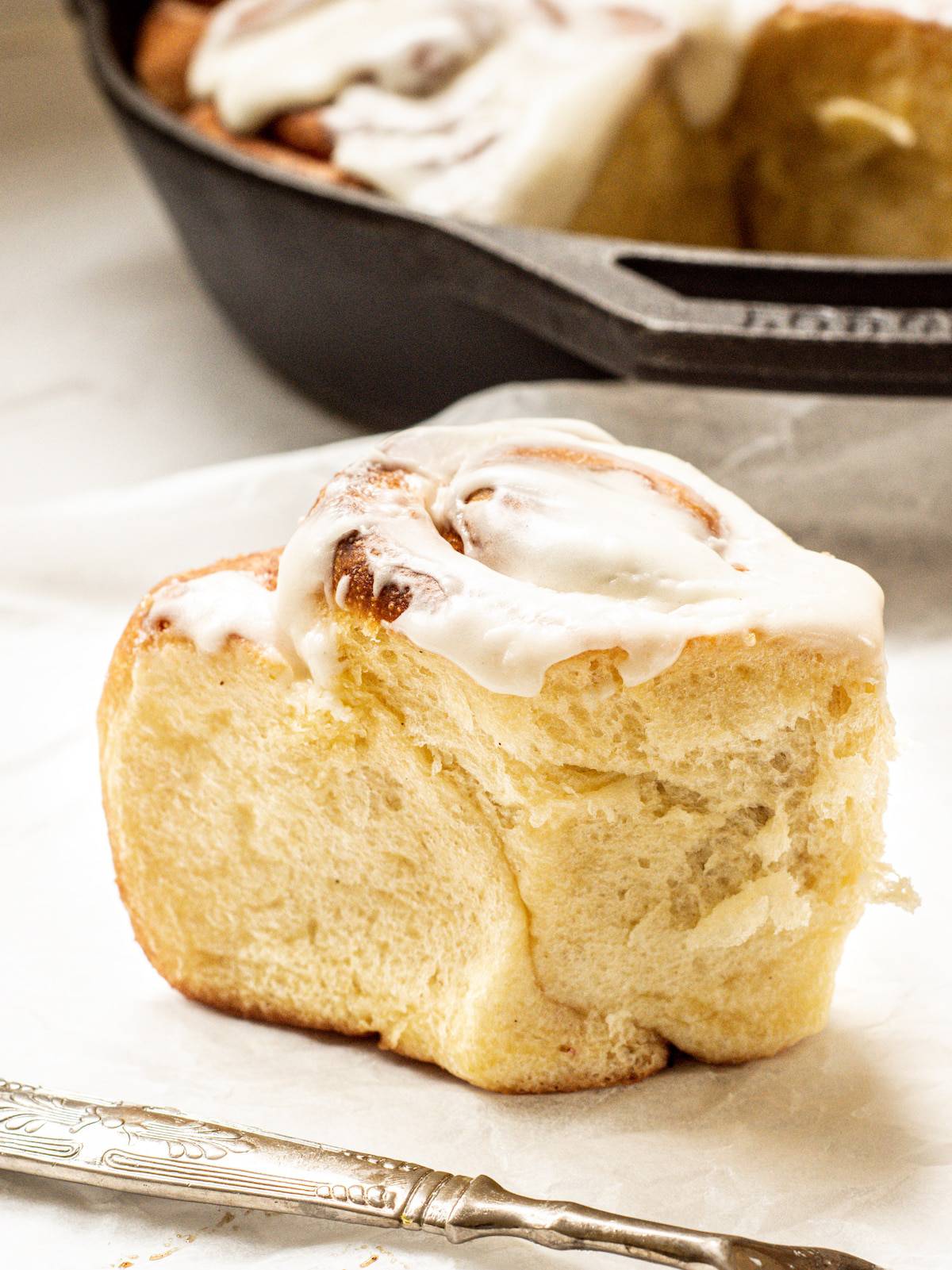
A brioche dough makes the best homemade cinnamon rolls. They are so soft and fluffy with a great, rich flavor. Brioche dough isn’t overly sweet, so it pairs very well with the cinnamon sugar filling and the sticky, sweet cream cheese glaze. It’s a very enriched dough with a large amount of butter and eggs. It undergoes multiple proofing times, including a cold refrigeration period, bringing extra flavor to the dough.
It’s a trickier dough to work with than regular cinnamon rolls, but it makes the best homemade cinnamon rolls. If you’re looking for a less rich dough, check out these small-batch sticky buns instead, or make challah bun dough which uses oil instead of butter.
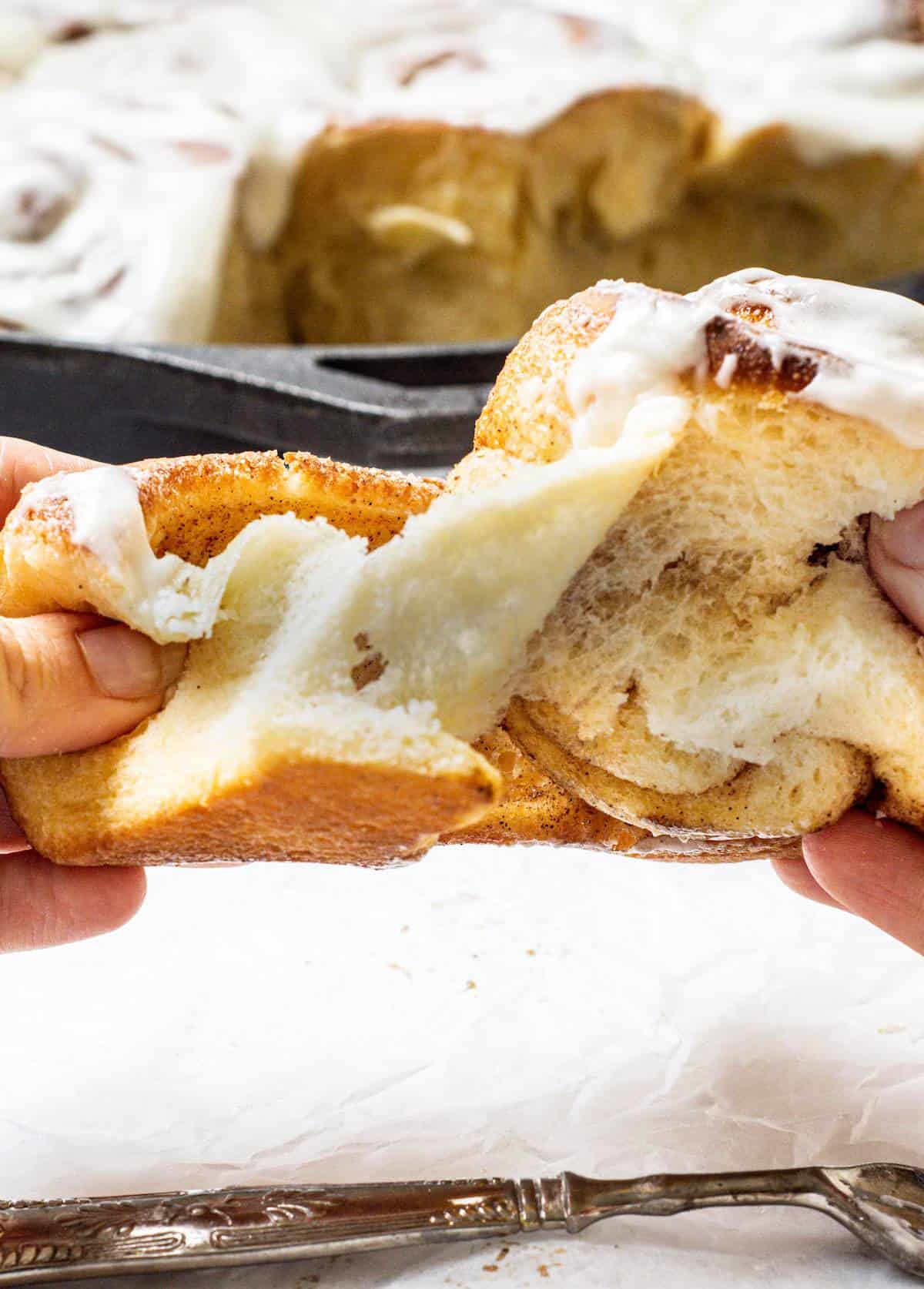
Ingredients
Find the ingredient amounts for the brioche cinnamon roll recipe in the printable recipe card at the bottom of this post. Here is a rundown of the dough ingredients.
- All-purpose flour- All-purpose flour is used for this recipe, one with a protein level of around 11%. This protein content is enough to develop the gluten but not too much that the bread becomes chewy. Using bread flour with protein levels can lead to chewy brioche.
- Yeast – The yeast used in this recipe can be instant yeast or active dry yeast. Instant yeast will rise faster than active dried yeast. Whichever one you use, it needs to be viable. Usually, the instant yeast sachets are usually pretty foolproof, but active dried yeast can sometimes lose viability. To test the viability of yeast before beginning, warm the milk (to around 95-104°F / 35-40°C) and mix in the yeast with one tablespoon of the sugar. Leave it to sit for 5-10 minutes first. If it becomes foamy, it’s good to go.
- Milk. This can be whole milk or skim milk.
- Large eggs.
- Granulated white sugar.
- Salt.
- Butter – The butter is a key component in buttery brioche dough. There is a lot of it. You can use salted or unsalted butter. If using salted butter, you can reduce the salt in the rest of the recipe to 1 teaspoon.
Baker’s schedule
For optimal flavor and texture, you’ll need to allow enough time for the dough to knead properly and to undergo multiple rising times. The best cinnamon rolls from brioche dough are overnight brioche cinnamon rolls made over a period of two days.
Day 1
- Knead the dough for around 20 minutes.
- Let it rise for approximately 2 hours at room temperature until doubled in size.
- Refrigerate the dough for 8-12 hours overnight.
Day 2
- The next morning, roll, shape, and cut the dough
- Let the rolls rise at room temperature until doubled in size
- Bake the brioche cinnamon rolls
Equipment
A stand mixer. The brioche dough is a very sticky dough to begin with. There is a large number of eggs and butter present, and this extra fat and moisture means gluten development in the dough is slow.
Use a stand mixer for best results, as the dough needs 15-20 minutes of mixing to create the gluten structure necessary for a strong and elastic dough.
This is optional, but a 12-inch/30cm cast-iron skillet is a great way to bake the brioche rolls. Use a 9 x 13-inch/ 23x33cm baking pan if you don’t have a skillet.
Method
- Add the warm milk and stir in the yeast and sugar in a stand mixer bowl fitted with a dough hook. To the yeast mixture, add the eggs, flour, and salt. Turn the mixer on low speed and combine until it forms a thick but slightly sticky dough. Mix this dough for around 5 minutes to begin developing the gluten.
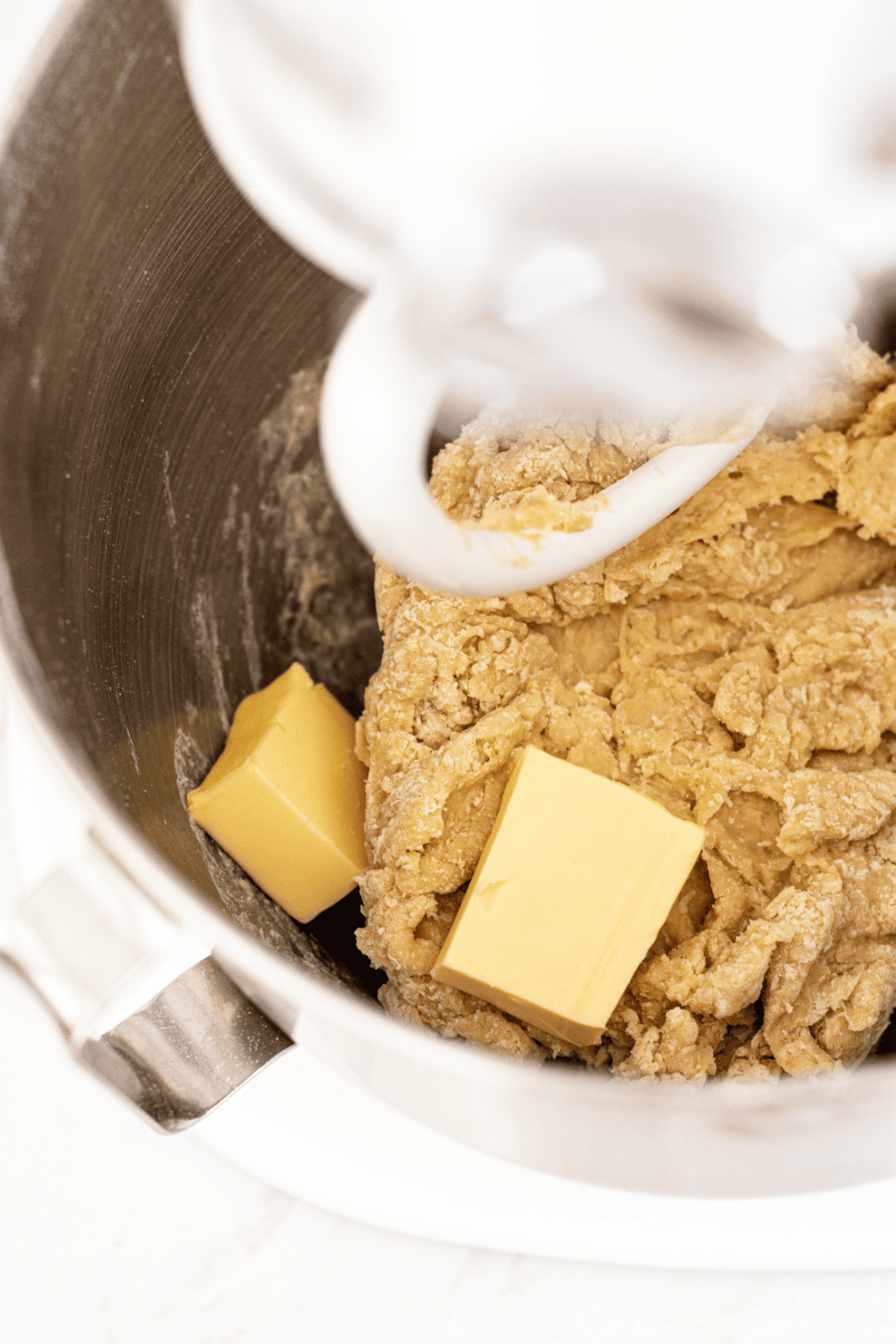
- Add in the soft butter, a little bit at a time. Incorporate each cube before the next addition.
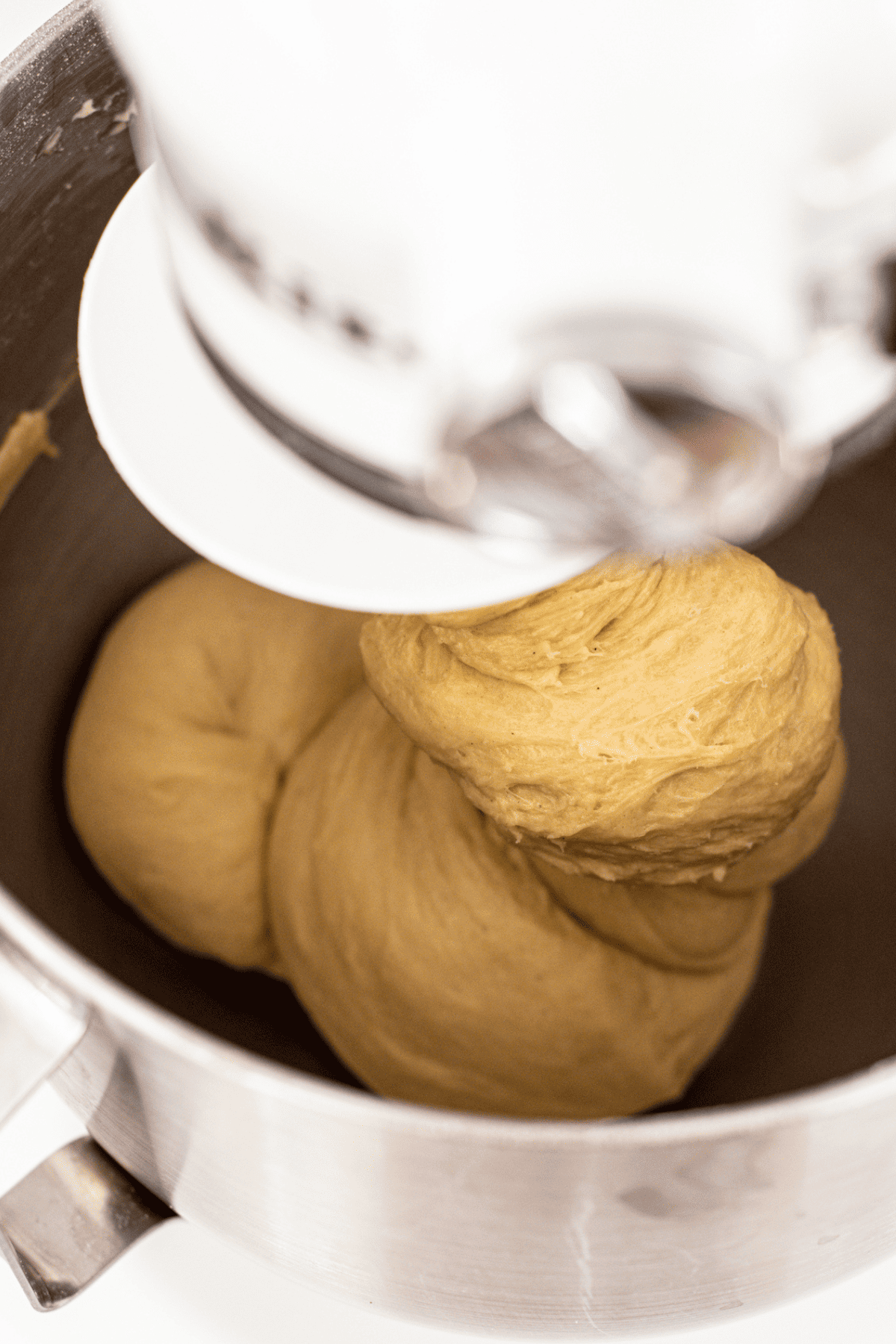
- Turn the mixer on medium speed and keep it mixing until the sticky dough strengthens, comes together, and pulls away cleanly from the sides of the bowl.
- Mix the dough for the best gluten development and brioche crumb for at least 15 minutes. Proper gluten development will allow you to stretch the dough so thin you can almost see through it. This is called the ‘window pane’ effect.
Mixing by hand
Mixing this dough by hand is possible, but you need to be prepared to use a lot of elbow grease. For a wet dough like this, using a slap-and-fold method is easiest – slap the dough down hard on the bench, pull it forward quickly, and repeat. Quick motions can stop the dough from sticking to your hands too much.
It will be very sticky, but do not be tempted to add more flour. Use a bench scraper to gather the dough back together if it gets too messy. after a while, you will feel strength in the dough.
It can be tiring, so that you can take breaks in between kneading the dough will respond well to it. Come back to it with clean and slightly damp hands.
Proofing The Brioche Dough
- Pull the dough from the large bowl onto a clean work surface and form it into a ball. Place the dough ball into a clean medium bowl. Cover it with a lid, plate, plastic wrap, or a damp tea towel, and let it proof at room temperature for 1.5- 2 hours until it doubles in size.
- Deflate the dough gently and reshape it into a rough ball again. Cover it with a lid, plastic wrap or a damp tea towel and place it in the fridge overnight. This step can be shortened, but 8-12 hours long cold proof gives the best flavor.
Shaping
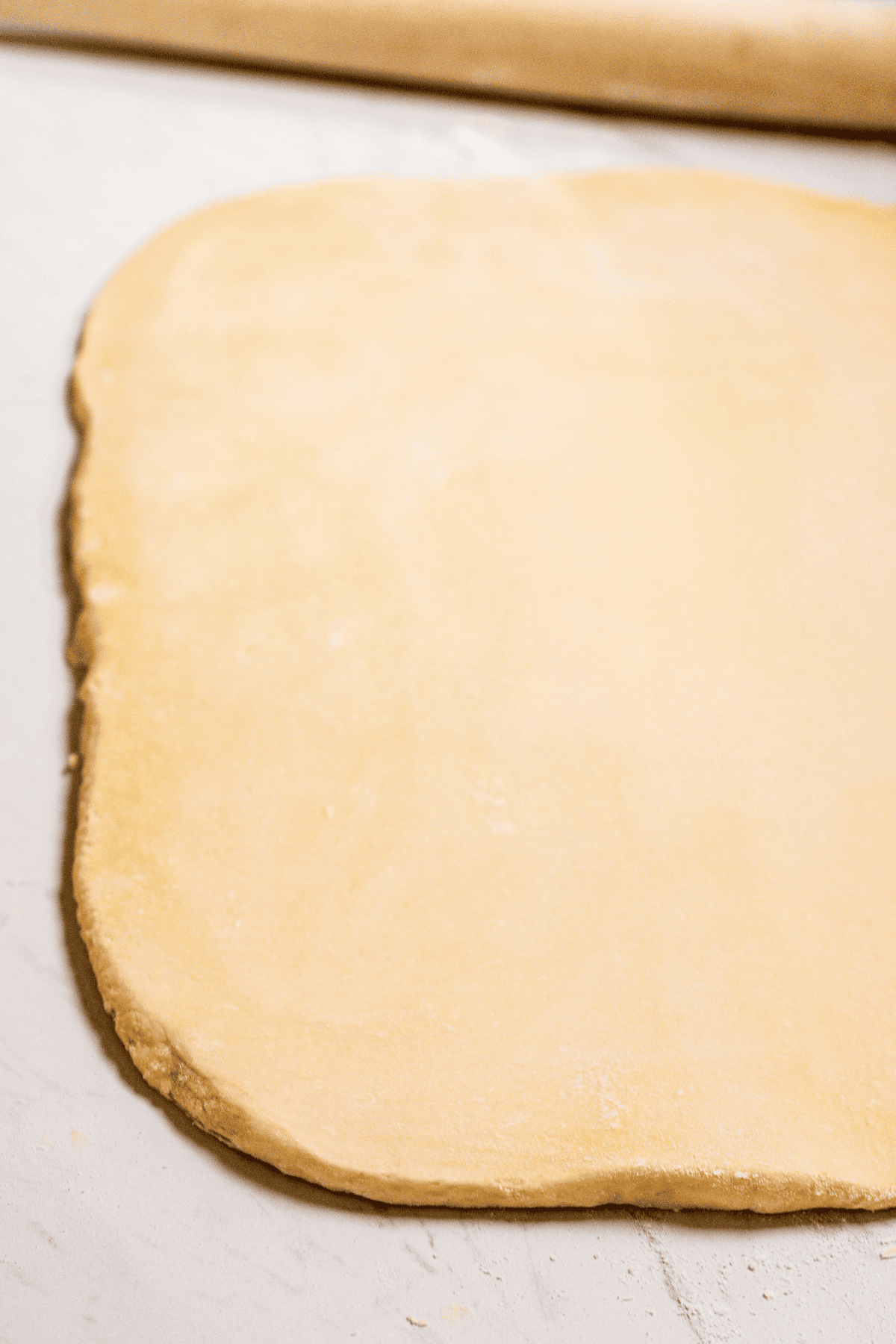
- Pull the proofed dough from the bowl and tip it onto a floured bench.
- Use a rolling pin to roll the dough into a 12×18 inch (30x45cm) large rectangle.
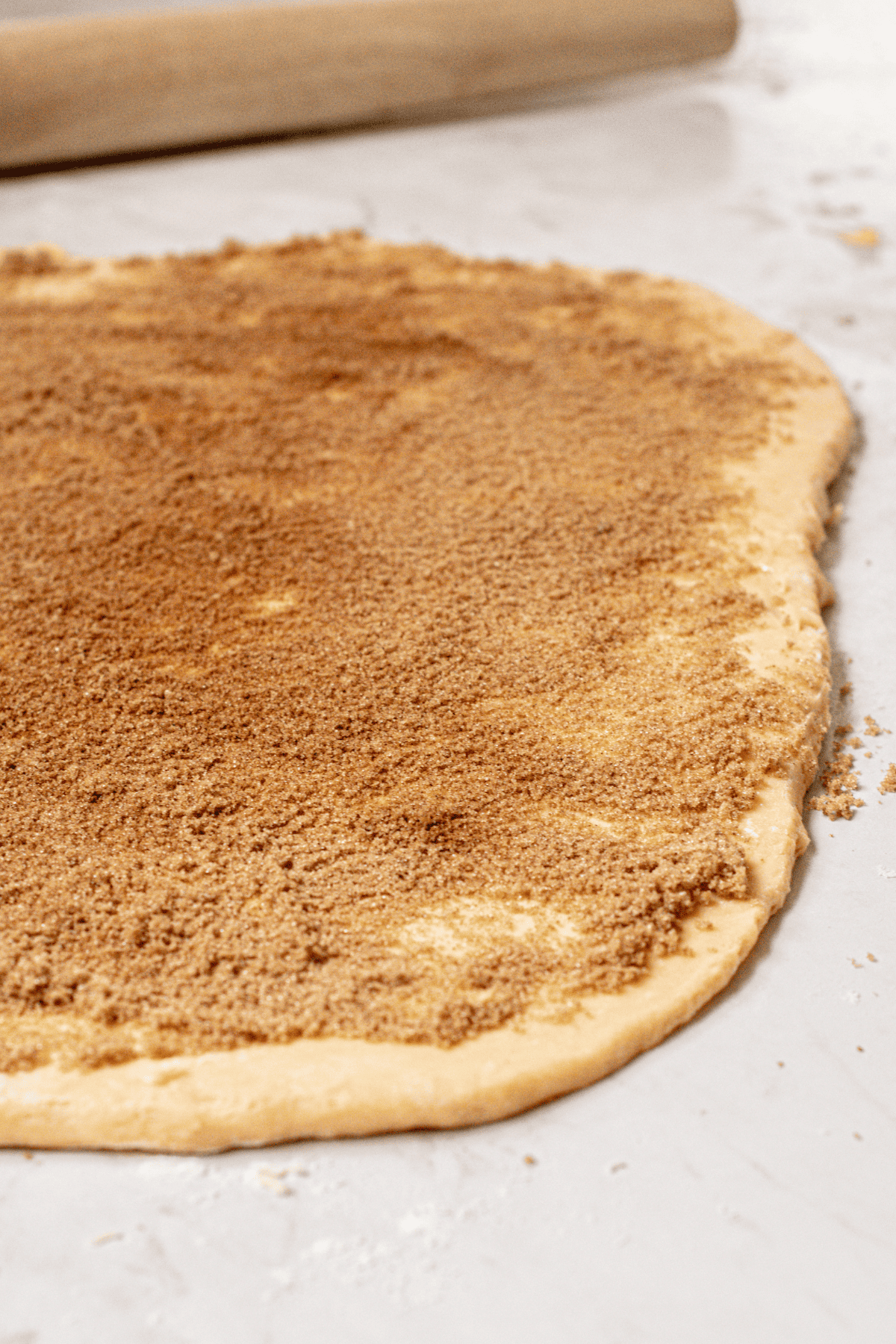
- Mix together the brown sugar and cinnamon in a small bowl. Spread softened butter in an even layer over almost the entire surface dough, leaving an inch border on the long side.
- Sprinkle cinnamon sugar over the butter.
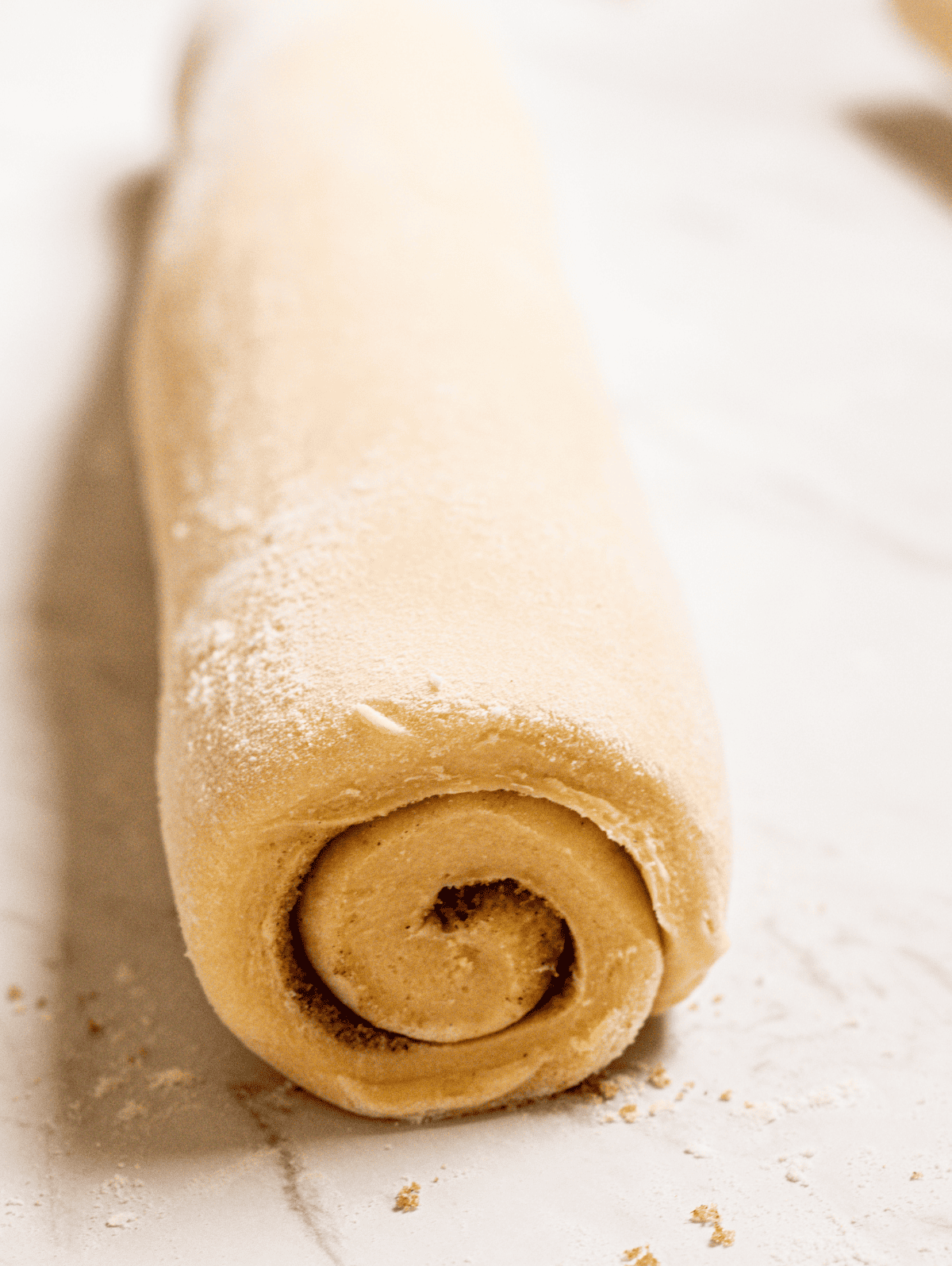
- Tightly roll up the dough to form an 18-inch/45cm long tight log, with the long edge facing you.
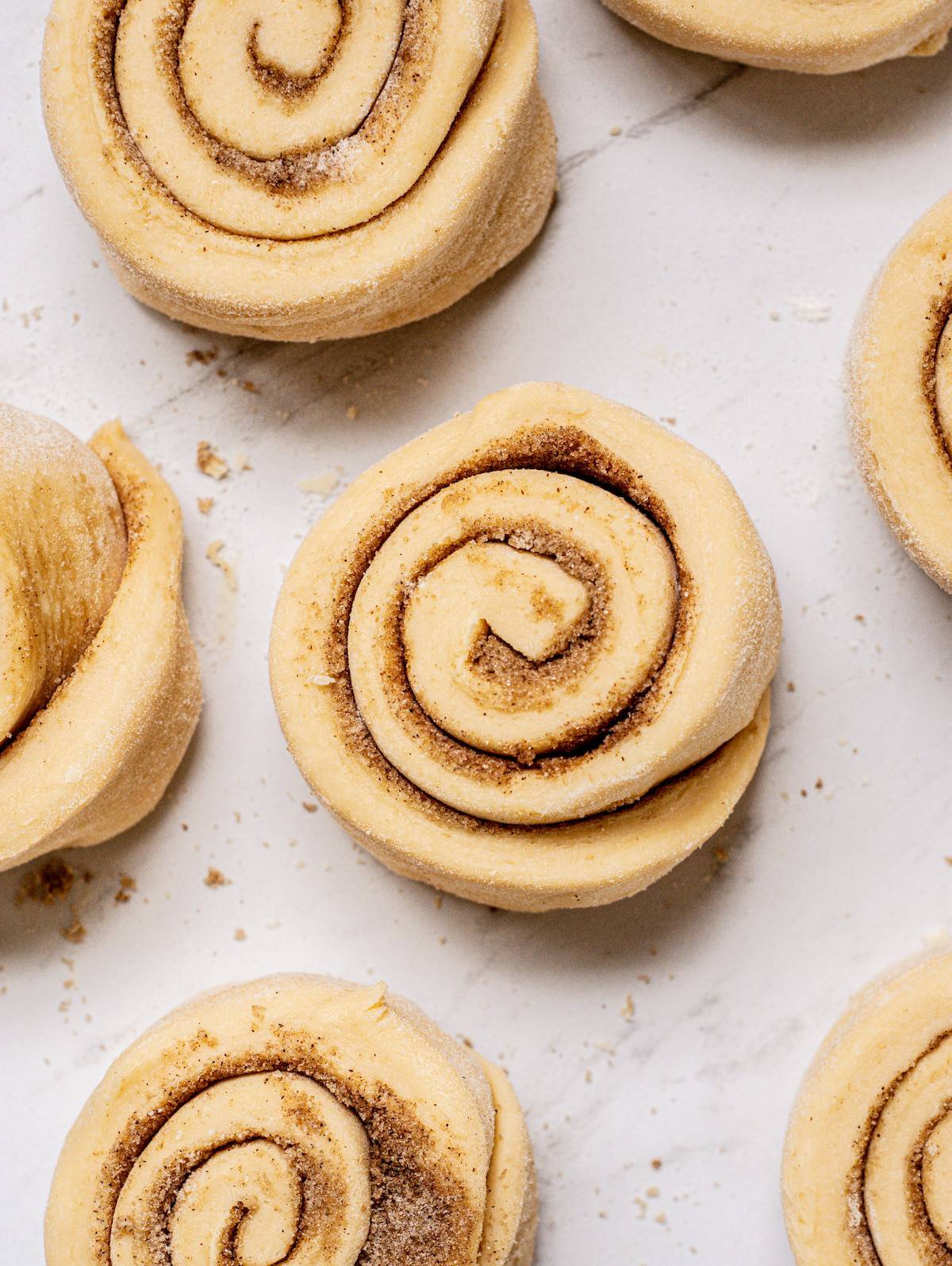
- Slice the log into 12 equal pieces using a serrated knife or unflavored dental floss. The unraveling end parts of each roll can be tucked under to keep them tight.
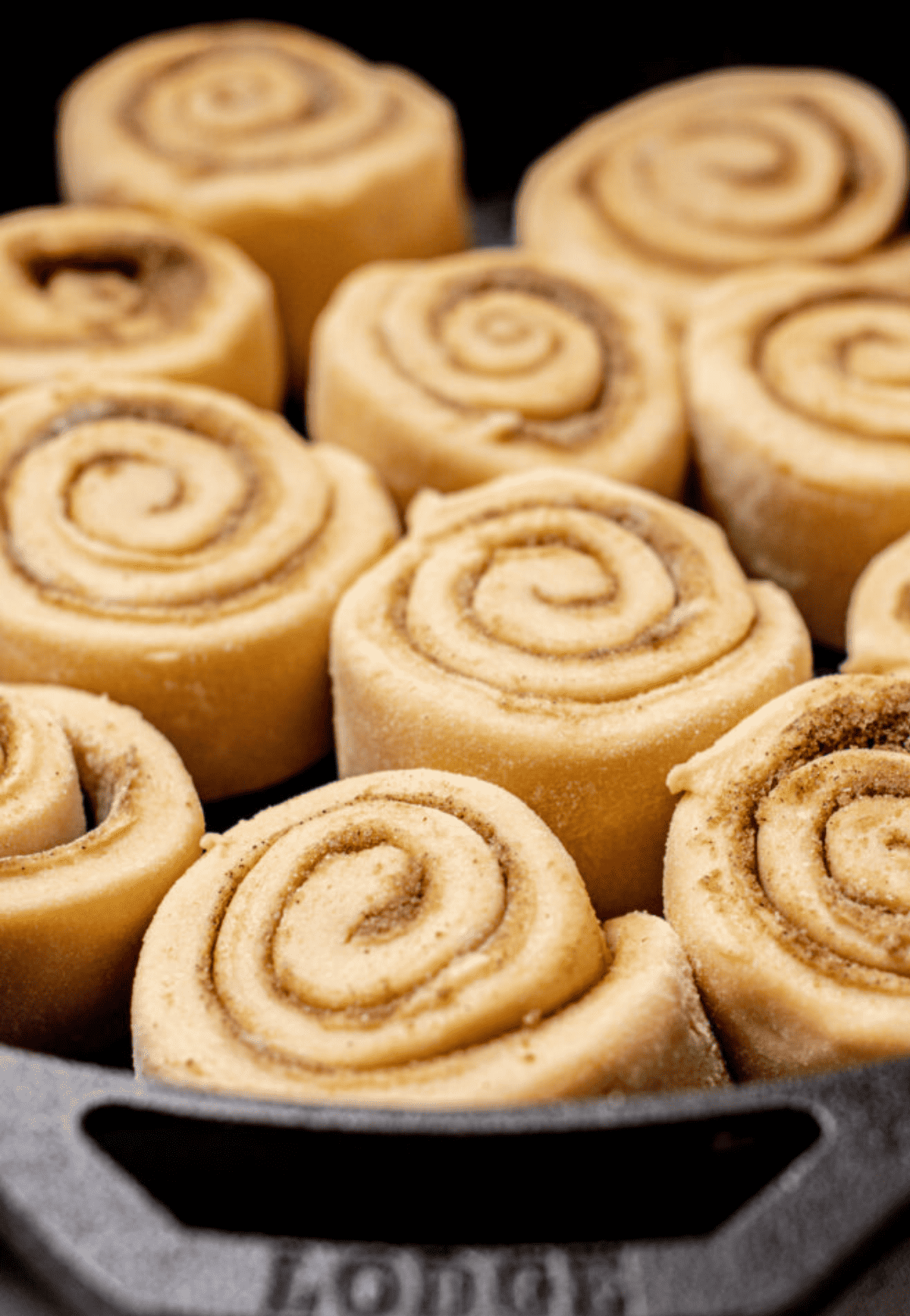
- Grease a 9×13-inch baking pan or 30-inch skillet and line with parchment paper.
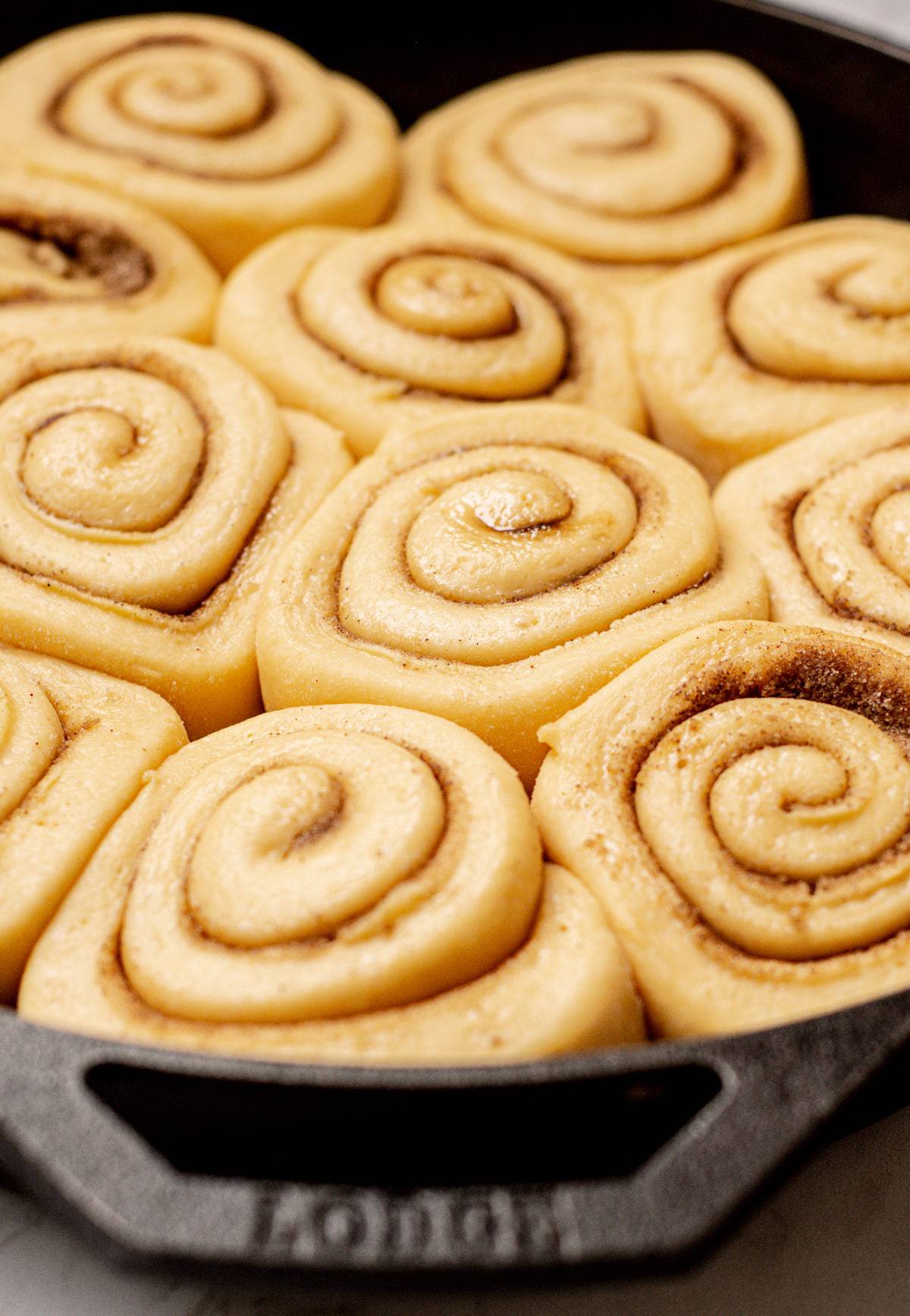
- Place rolls in the prepared pan and let the shaped dough rise in a warm place until doubled in size.
- Preheat the oven to 350°F/180°C. Bake the brioche cinnamon rolls for approximately 25-28 minutes until the tops are puffed up and golden brown.
Cream cheese frosting
- Beat the cream cheese in a mixer with a paddle attachment until smooth and creamy. Add powdered sugar, vanilla, and milk. Beat it together until creamy. Spread the icing over the still-warm cinnamon rolls and serve the warm rolls immediately.
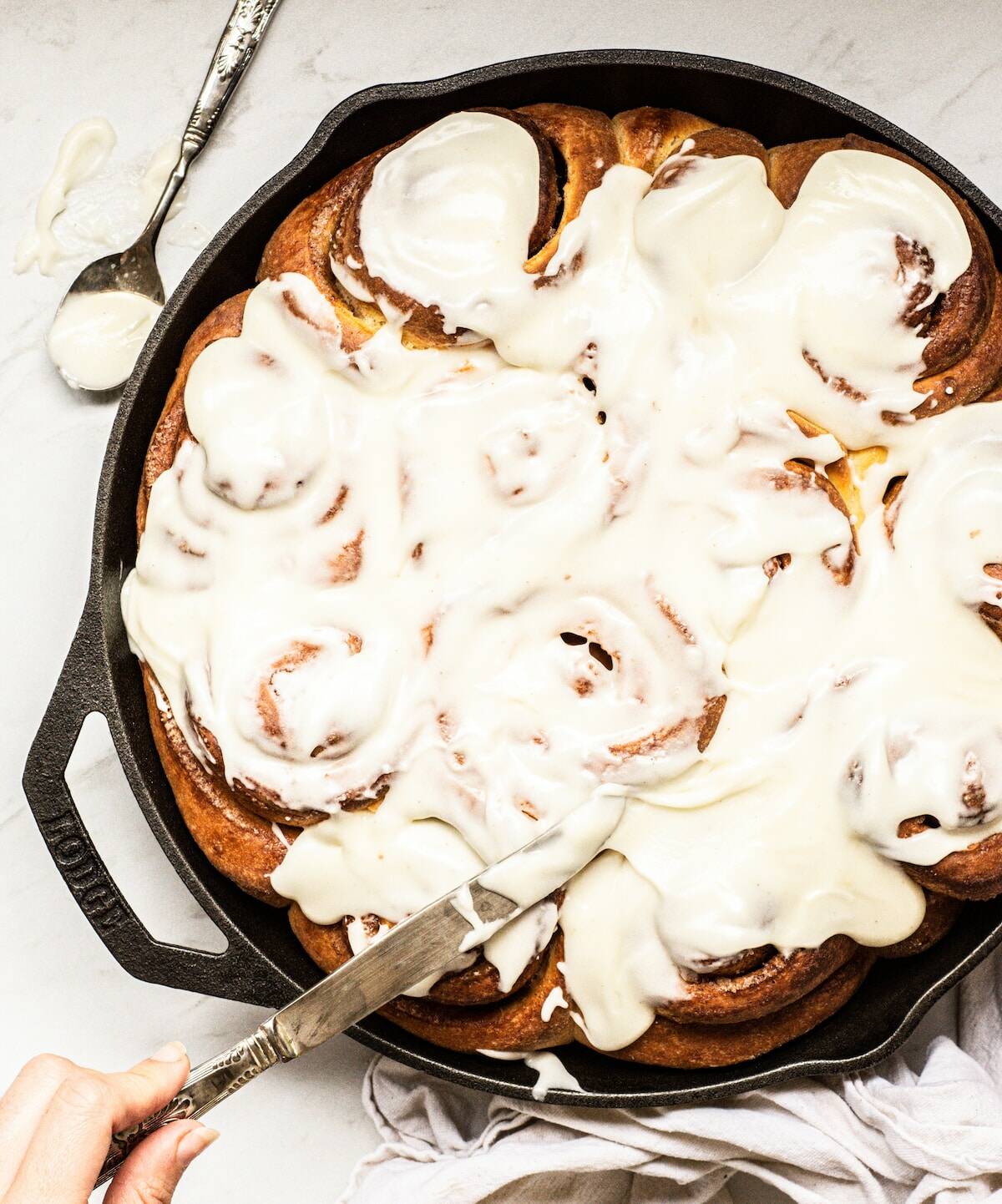
Storing
Leftover brioche cinnamon rolls can be stored at room temperature in an airtight container for up to 3 days. Happy baking!
FAQS
Brioche cinnamon rolls are made using a richer and more buttery than standard dough. This results in a softer, more tender, and flavorful roll with a slightly flaky texture.
Several factors can affect the rise. It might be old or expired yeast, your milk was too hot and may have killed the yeast, the dough rising environment was too cold, or it wasn’t given enough time to rise.
If you’re looking to get a head start, you can prepare the dough earlier on and then refrigerate it. This allows you to shape the rolls fresh in the morning. On the other hand, if you prefer to have them ready to go, you can both prepare and shape the rolls a day in advance. Then, place them in the refrigerator for an overnight, slow-rise process. When morning comes, they’ll be all set for you to bake immediately.
Yup, they freeze well. Allow the rolls to cool completely, then wrap them in plastic or aluminum foil. Store in a freezer bag for up to 2 months. Thaw and reheat in the oven or microwave when ready to serve.
You could add ingredients like chopped nuts, raisins, or even chocolate chips to the filling. This dough makes a delicious chocolate chip brioche loaf too!
Add the ingredients as the machine’s manufacturer recommends, and let the machine handle the kneading. Once the dough cycle is complete, you can shape and fill the rolls.
Related recipes
Looking at what else you can bake using your cast-iron pan? Why not learn to make a sourdough starter and bake your first loaf of sourdough bread with caraway seeds?
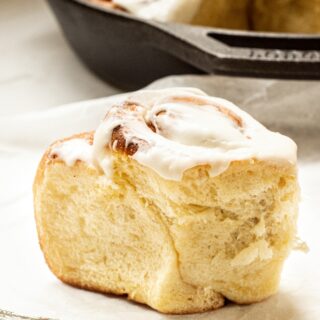
The Softest Brioche Cinnamon Rolls
Equipment
Ingredients
- 125 g warm milk (95-104°F / 35-40°C)
- 2 ½ tsp instant yeast or active dried yeast
- 50 g granulated sugar
- 600 g all-purpose flour
- 5 large eggs approx. 260g-270g excluding shell.
- 1 ½ tsp salt
- 230 g unsalted butter, at room temperature and cut into cubes
Cinnamon Filling
- 75 g unsalted butter, softened
- 100 g soft brown sugar
- 1 Tbsp ground cinnamon
Vanilla Cream Cheese Icing
- 60 g cream cheese, at room temperature
- 150 g confectioners sugar
- 2 Tbsp milk at room temperature
- 1/2 tsp vanilla extract
Instructions
- In a bowl of a stand mixer fitted with a dough hook, add the milk and stir in the yeast and one tablespoon of sugar. Leave it to sit for 5-10 minutes until foamy. Add to it the remaining sugar, eggs, flour, and salt. Turn the mixer on low and combine until it forms a thick but slightly sticky dough. Mix this dough for around 5 minutes to begin developing
- Add in the cubed butter, a few pieces at a time. Incorporate each cube before the next addition.
- Turn the mixer on medium and keep it mixing until the sticky dough starts to strengthen and come together and pull away cleanly from the sides of the bowl. For the best gluten development and brioche crumb, mix the dough for at least 15 minutes. Proper gluten development will allow you to stretch the dough so thin you can almost see through it. This is called the 'window pane' effect.
- Pull the dough from the bowl onto a bench and form it into a ball. Place the dough ball into a clean bowl and cover it. Let it proof at room temperature for 1.5- 2 hours until doubled in size. The rising time will happen fastest with instant yeast and slower with active dried yeast.
- Deflate the dough gently and reshape it into a rough ball again. Cover it lid or plate, or a damp tea towel and place it in the fridge overnight. This step can be shortened, but a long cold proof of 8-12 hours gives the best flavor.
- Pull the proofed dough from the bowl and tip it onto a floured bench. Roll the dough out into a 12×18 inch (30x45cm) rectangle. Spread softened butter over the dough. In a bowl, mix together the brown sugar and ground cinnamon. Sprinkle the cinnamon sugar over the butter. Tightly roll the dough to form an 18-inch/45cm long log. Slice the log into 12 even-sized pieces. The unraveling end parts of each roll can be tucked under to keep them tight.
- Grease a 12-inch/30cm cast-iron skillet or 9×13 inch/23x33cm baking dish. Place in the rolls and cover them with a light-weight, slightly dampened kitchen towel (to stop the tops drying out). Let them rise at room temperature, puffy, and doubled in size.
- Preheat the oven to 350°F/180°C.
- Bake the brioche cinnamon rolls for approximately 25-28 minutes until puffed up and browned on the tops. The rolls can be covered with aluminum foil halfway through baking if the tops are browning too fast. After baking, let them cool for 10 minutes before glazing.
The frosting
- Beat the cream cheese in a mixer until smooth and creamy. Add the confectioners’ sugar, vanilla, and milk. Beat it together until creamy. Spread the icing over the still-warm cinnamon rolls and serve immediately.
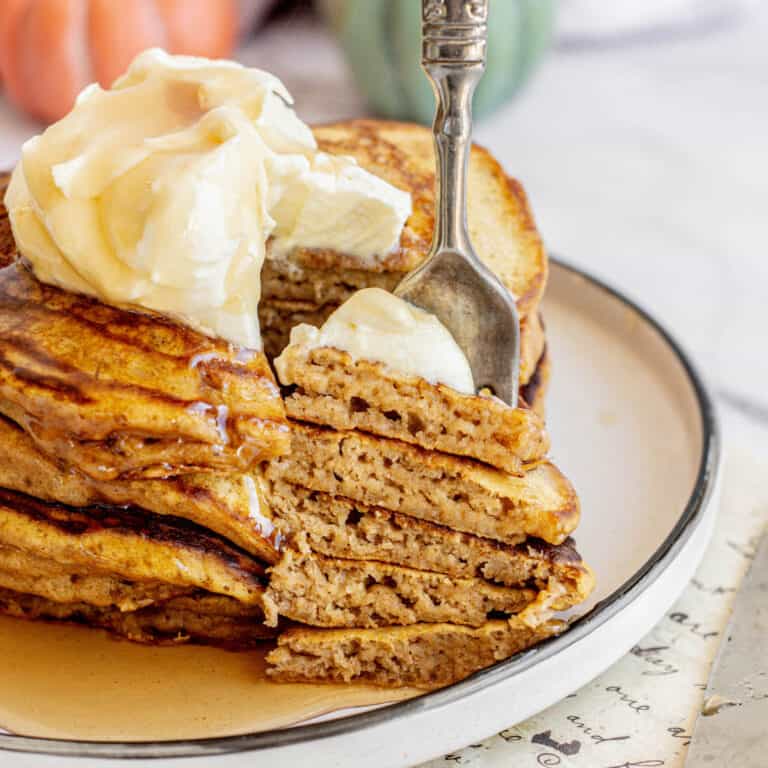
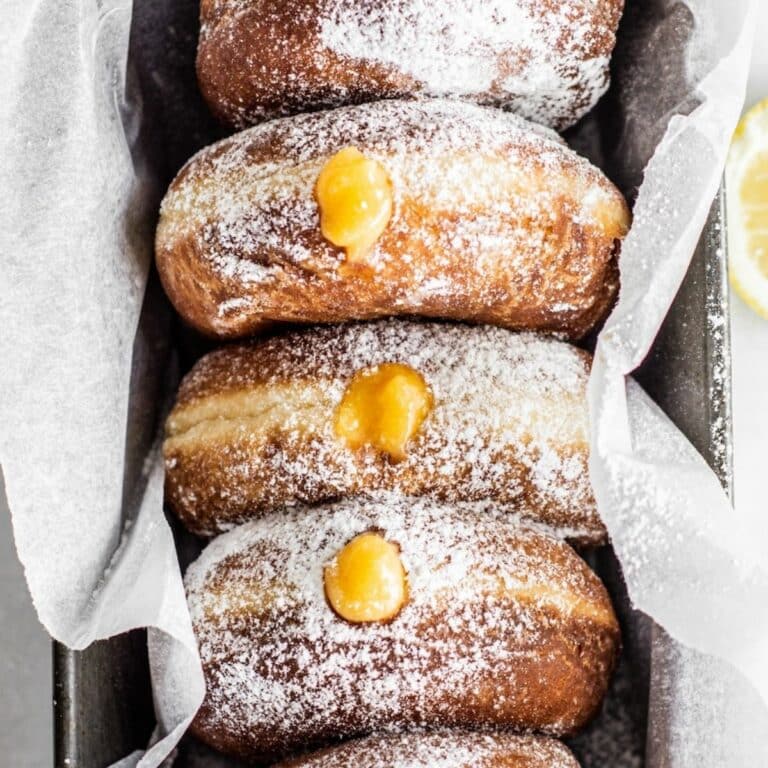
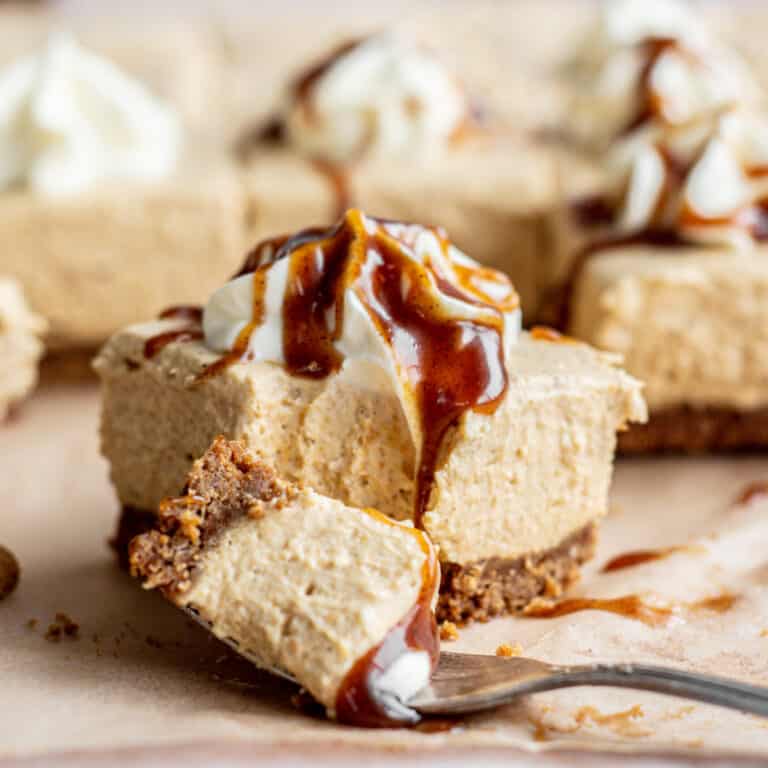
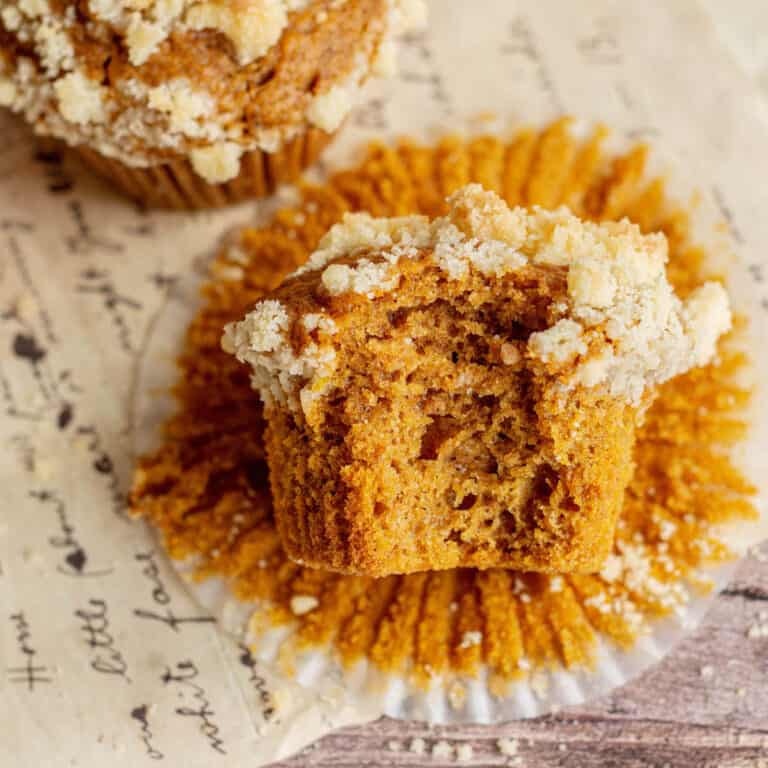
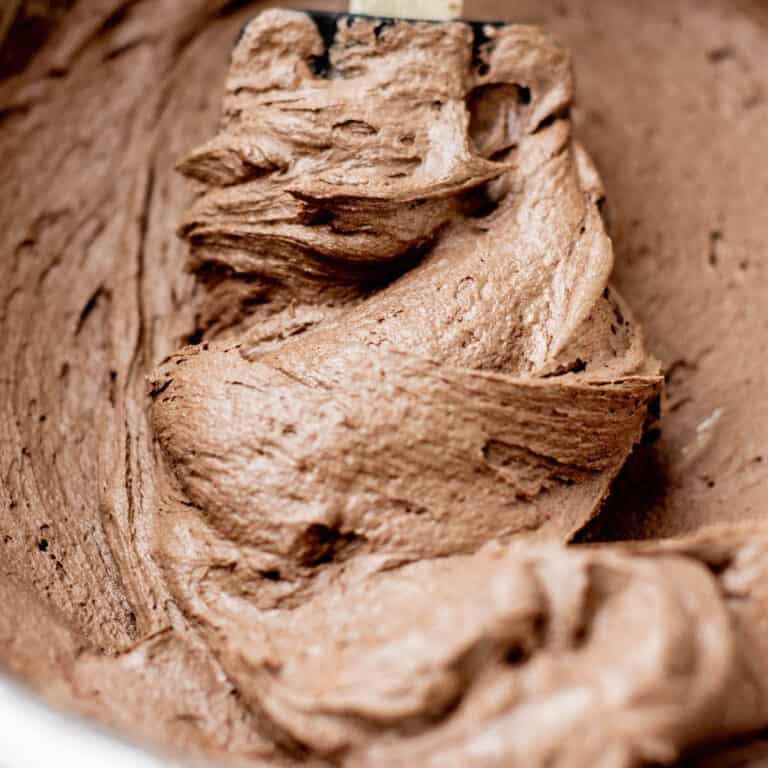

Can I make this recipe and not bake 2 days before and refrigerate and bake Christmas morning.
Hey yes you can refrigerate the dough up to 2 days, but I wouldn’t fill and shape the dough that far in advance. You can refrigerate the bowl of dough, but I’d wait to do the shaping and last rise until the evening before you need them (and then they can rise again slowly overnight in the fridge).
These are the best cinnamon rolls I have ever tasted. I did increase my sugar in the dough to a half a cup and I also increased my butter in the filling to one stick and one cup of brown sugar. I guess I just have a sweet tooth but this dough is amazing.
That’s great to hear Lynn! So happy you loved them!
These rolls were delicious. Almost as good as my grandmothers (can anyone beat grammy’s baking?) Will absolutely make them again with one change, lower the oven temp. My browned too quickly even though I covered them. Still great and not dried out.
This was such a beautiful dough to work with! Worth every minute and every ounce of butter!
I totally agree! One of my fave doughs to work with. So happy you loved it too!
This is a fantastic dough! The cinnamon rolls were perfect, better than the “chain store”. I’m going to use this dough to make all kinds of goodies! Thanks for the recipe!
So happy you loved it Lori!
I made these rolls last night…the dough came together beautifully and these were hands down the BEST cinnamon rolls I have ever made. Definitely in our recipe rotation!
Can I freeze this recipe?
The baked rolls can be frozen for up to 3 months 🙂
You have very good recipe!
I did have good laugh though, the part about the weight of the eggs excluding the shell 🙂
About thirty years ago I went to culinary school. During the baking section of the program, I had a classmate that had a hard time following recipes.
When the recipe called for eggs, he would put the entire egg in the mixer.
When it called for bananas, he would put the whole banana in the mixture.
Again, you recipe is a very good recipe!
Thank you for sharing.
I had a couple issues. I think the oven temp was a bit too high for my gas oven. Very brown on top, even when covered, and center not completely baked! The flavour was awesome!! I will make it again with a couple tweaks. I also will add a bit more cream cheese to the icing for a bit more tang!
How long can the iced rolls be left out at room temp? With cream cheese in the frosting, do they HAVE to be refrigerated if not consumed that day? Thanks!
Heya the iced rolls can be stored at room temperature for up to 2 days 🙂
I am trying out this recipe for the first time. I was wondering if I can use a glass pan instead of using a cast iron?
Hey yes you definitely can, a 9×13 inch 🙂
What kind of milk do you recommend? Whole milk? Or is 2% okay?
Either will work 😊
is it possible to overnight proof filled and cut? If they will go in the oven very early in the morning?
Yes you could – I would shorten the first fridge rise of the dough to just a couple of hours, then shape the rolls in the evening, tightly cover, and let the shaped rolls rise in the refrigerator overnight 🙂
I discovered brioche a couple years ago and have been obsessed with the texture. These turned out better than any store brought brioche. Well worth all the butter!! and eggs. Amazing!! Looking forward to switching up the fillings. Maybe a savory version would be yum. Thankyou for the recipe.
So happy you loved it Victoria!! A savory version would be delish 😍
Beautiful recipe! If we don’t do an overnight proof can we still make these? What do you suggest? Thanks!
Definitely! They will still be great without an overnight proof 🙂
Can this dough be made in the bread machine instead of a stand mixer?
Yup you can mix it in that 🙂
Hi! If I say put the dough in the fridge for the second proof at 12pm (Sunday), is it ok to let it sit in the fridge for 24 hours (until 12 pm Monday) before shaping and baking it on Monday afternoon? Will the dough be overproofed ?
Hey that will be fine to leave in the fridge til then and shape after 🙂
What will be the texture of the cold proofed dough? is it normal to be hard? Should i let it out for few hours at room temperature before shaping it?
How do I know when the buns have doubled in size?
Hey they should look puffy, and be squished together in the pan 🙂
Can I double this recipe? Would I double the yeast also? ☺️
Heya, you can double this recipe! You can double the yeast as well, or use a bit less to slow the rise. Either works! 🙂
What’s the longest I can proof the dough in the fridge without compromising the taste?
Hey, you can refrigerate the unshaped dough for up to 48 hours 🙂
I made these.
I used active yeast and only proofed for 1 hour.
I skipped flouring the counter top because my dough Was not sticking to the counter at all…… how ?
Less butter.
1/4 cup in dough.
1/4 cup in cinnamon filling.
I created vanilla brioche dough by using 1-1/2 tablespoons vanilla extract.
To the cinnamon filling I added splash of cream and instant espresso. Instead of butter onto the rolled dough, I used enough heavy cream to make the filling stick. Then instead of a frosting. I made a thick caramel sauce that I used over the tops of the baked cinnamon rolls. The result was amazing and very non-traditional flavors.
Will make again for sure. I only got 9 big rolls.